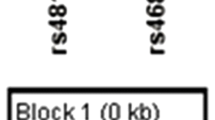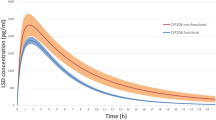Abstract
Polydipsia is a serious condition often seen among patients with schizophrenia (SCZ). The cause of polydipsia is unknown; hence, it is hard to treat or manage. Animal studies showed that the drinking behavior is regulated by central dopaminergic neurotransmission at the hypothalamus. Meanwhile, the existence of a genetic predisposition to polydipsia in patients with SCZ has been suggested. The purpose of this study was to assess whether a functional polymorphism, Val108/158Met in the gene for catechol-O-methyltransferase (COMT), is associated with susceptibility to polydipsia using a Japanese sample of SCZ. Our sample includes 330 chronic patients with SCZ (83 polydipsic patients and 247 non-polydipsic controls). The common COMT Val108/158Met polymorphism was genotyped, and the differences in genotype distribution and allele frequency between cases and controls were evaluated using the χ 2 test. A significant association between the COMT Val108/158Met polymorphism and polydipsia was found (genotype distribution: χ 2 = 13.0, df = 2, p = 0.001; allele frequency: χ 2 = 7.50, df = 1, p = 0.006). The high-COMT activity group (Val/Val) was more frequent among patients with polydipsia compared with the low-COMT activity group (Val/Met + Met/Met) [odds ratio (OR) = 2.46]. The association survived after controlling for other possible confounding factors, including gender, age, age of onset, current antipsychotic dose, and smoking status. Our results suggest that the COMT Val108/158Met genotype may confer susceptibility to polydipsia in SCZ. To our knowledge, this is the first association study between the COMT gene and polydipsia in SCZ. Further studies with larger sample sizes are warranted to confirm present findings.

Similar content being viewed by others
References
Assal, F., & Chauchot, F. (1994). Hyponatremia of therapeutic origin. Apropos of a case. Encephale, 20(5), 527–529.
Barnett, J. H., Scoriels, L., & Munafo, M. R. (2008). Meta-analysis of the cognitive effects of the catechol-O-methyltransferase gene Val158/108Met polymorphism. Biological Psychiatry, 64(2), 137–144. doi:10.1016/j.biopsych.2008.01.005.
Canuso, C. M., & Goldman, M. B. (1999). Clozapine restores water balance in schizophrenic patients with polydipsia–hyponatremia syndrome. Journal of Neuropsychiatry and Clinical Neurosciences, 11(1), 86–90.
de Leon, J., Verghese, C., Stanilla, J. K., Lawrence, T., & Simpson, G. M. (1995). Treatment of polydipsia and hyponatremia in psychiatric patients. Can clozapine be a new option? Neuropsychopharmacology, 12(2), 133–138. doi:10.1016/0893-133X(94)00069-C.
de Leon, J., Verghese, C., Tracy, J. I., Josiassen, R. C., & Simpson, G. M. (1994). Polydipsia and water intoxication in psychiatric patients: A review of the epidemiological literature. Biological Psychiatry, 35(6), 408–419.
Delva, N. J., Crammer, J. L., Lawson, J. S., Lightman, S. L., Sribney, M., & Weier, B. J. (1990). Vasopressin in chronic psychiatric patients with primary polydipsia. British Journal of Psychiatry, 157, 703–712.
Dourish, C. T. (1983). Dopaminergic involvement in the control of drinking behaviour: A brief review. Progress in Neuro-Psychopharmacology and Biological Psychiatry, 7(4–6), 487–493.
Egan, M. F., Goldberg, T. E., Kolachana, B. S., Callicott, J. H., Mazzanti, C. M., Straub, R. E., et al. (2001). Effect of COMT Val108/158 Met genotype on frontal lobe function and risk for schizophrenia. Proceedings of the National Academy of Sciences, 98(12), 6917–6922. doi:10.1073/pnas.111134598.
Ferrier, I. N. (1985). Water intoxication in patients with psychiatric illness. British Medical Journal (Clinical Research Ed), 291(6509), 1594–1596.
Fukunaka, Y., Shinkai, T., Hwang, R., Hori, H., Utsunomiya, K., Sakata, S., et al. (2007). The orexin 1 receptor (HCRTR1) gene as a susceptibility gene contributing to polydipsia–hyponatremia in schizophrenia. Neuromolecular Medicine, 9(4), 292–297. doi:10.1007/s12017-007-8001-2.
Fuller, M. A., Jurjus, G., Kwon, K., Konicki, P. E., & Jaskiw, G. E. (1996). Clozapine reduces water-drinking behavior in schizophrenic patients with polydipsia. Journal of Clinical Psychopharmacology, 16(4), 329–332.
Goldman, M. B., Luchins, D. J., & Robertson, G. L. (1988). Mechanisms of altered water metabolism in psychotic patients with polydipsia and hyponatremia. New England Journal of Medicine, 318(7), 397–403. doi:10.1056/NEJM198802183180702.
Henderson, D. C., & Goff, D. C. (1994). Clozapine for polydipsia and hyponatremia in chronic schizophrenics. Biological Psychiatry, 36(11), 768–770.
Huotari, M., Garcia-Horsman, J. A., Karayiorgou, M., Gogos, J. A., & Mannisto, P. T. (2004). D-amphetamine responses in catechol-O-methyltransferase (COMT) disrupted mice. Psychopharmacology (Berl), 172(1), 1–10. doi:10.1007/s00213-003-1627-3.
Illowsky, B. P., & Kirch, D. G. (1988). Polydipsia and hyponatremia in psychiatric patients. American Journal of Psychiatry, 145(6), 675–683.
Jones, B. D. (1984). Psychosis associated with water intoxication: Psychogenic polydipsia or concomitant dopaminergic supersensitivity disorders? Lancet, 2(8401), 519–520.
Kishimoto, T., Hirai, M., Ohsawa, H., Terada, M., Matsuoka, I., & Ikawa, G. (1989). Manners of arginine vasopressin secretion in schizophrenic patients—with reference to the mechanism of water intoxication. The Japanese Journal of Psychiatry and Neurology, 43(2), 161–169.
Lachman, H. M., Papolos, D. F., Saito, T., Yu, Y. M., Szumlanski, C. L., & Weinshilboum, R. M. (1996). Human catechol-O-methyltransferase pharmacogenetics: Description of a functional polymorphism and its potential application to neuropsychiatric disorders. Pharmacogenetics, 6(3), 243–250.
Lawson, W. B., Karson, C. N., & Bigelow, L. B. (1985). Increased urine volume in chronic schizophrenic patients. Psychiatry Research, 14(4), 323–331.
Matsumoto, C., Shinkai, T., De Luca, V., Hori, H., Hwang, R., Ohmori, O., et al. (2006). Association study between functional polymorphisms in the cytochrome P450 1A2 and 2D6 genes and polydipsia in schizophrenia. Neuromolecular Medicine, 8(3), 381–388. doi:10.1385/NMM:8:3:381.
Mittleman, G., Rosner, A. L., & Schaub, C. L. (1994). Polydipsia and dopamine: Behavioral effects of dopamine D1 and D2 receptor agonists and antagonists. Journal of Pharmacology and Experimental Therapeutics, 271(2), 638–650.
Owen, M. J. (2005). Genomic approaches to schizophrenia. Clinical Therapeutics, 27(Suppl A), S-2–S-7. doi:10.1016/j.clinthera.2005.07.014.
Raskind, M. A., Orenstein, H., & Christopher, T. G. (1975). Acute psychosis, increased water ingestion, and inappropriate antidiuretic hormone secretion. American Journal of Psychiatry, 132(9), 907–910.
Sarai, M., & Matsunaga, H. (1989). ADH secretion in schizophrenic patients on antipsychotic drugs. Biological Psychiatry, 26(6), 576–580.
Shen, W. W., & Sata, L. S. (1983). Hypothalamic dopamine receptor supersensitivity? A pilot study of self-induced water intoxication. Psychiatric Journal of the University of Ottawa, 8(3), 154–158.
Shinkai, T., De Luca, V., Utsunomiya, K., Sakata, S., Inoue, Y., Fukunaka, Y., et al. (2008). Functional polymorphism of the human multidrug resistance gene (MDR1) and polydipsia–hyponatremia in schizophrenia. Neuromolecular Medicine, 10(4), 362–367. doi:10.1007/s12017-008-8041-2.
Shinkai, T., Ohmori, O., Hori, H., & Nakamura, J. (2003). Genetic approaches to polydipsia in schizophrenia: A preliminary report of a family study and an association study of an angiotensin-converting enzyme gene polymorphism. American Journal of Medical Genetics Part B: Neuropsychiatric Genetics, 119B(1), 7–12. doi:10.1002/ajmg.b.10066.
Silverstein, E., Sokoloff, L., Mickelsen, O., & Jay, G. E. (1961). Primary polydipsia and hydronephrosis in an inbred strain of mice. American Journal of Pathology, 38(2), 143–159.
Smith, W. O., & Clark, M. L. (1980). Self-induced water intoxication in schizophrenic patients. American Journal of Psychiatry, 137(9), 1055–1060.
Spears, N. M., Leadbetter, R. A., & Shutty, M. S, Jr. (1996). Clozapine treatment in polydipsia and intermittent hyponatremia. Journal of Clinical Psychiatry, 57(3), 123–128.
Spigset, O., & Hedenmalm, K. (1995). Hyponatraemia and the syndrome of inappropriate antidiuretic hormone secretion (SIADH) induced by psychotropic drugs. Drug Safety, 12(3), 209–225.
Tan, H. Y., Chen, A. G., Chen, Q., Browne, L. B., Verchinski, B., Kolachana, B., et al. (2012). Epistatic interactions of AKT1 on human medial temporal lobe biology and pharmacogenetic implications. Molecular Psychiatry, 17(10), 1007–1016. doi:10.1038/mp.2011.91.
Van Amelsvoort, T., Bakshi, R., Devaux, C. B., & Schwabe, S. (1994). Hyponatremia associated with carbamazepine and oxcarbazepine therapy: A review. Epilepsia, 35(1), 181–188.
Verghese, C., de Leon, J., & Josiassen, R. C. (1996). Problems and progress in the diagnosis and treatment of polydipsia and hyponatremia. Schizophrenia Bulletin, 22(3), 455–464.
Verghese, C., De Leon, J., & Simpson, G. M. (1993). Neuroendocrine factors influencing polydipsia in psychiatric patients: An hypothesis. Neuropsychopharmacology, 9(2), 157–166. doi:10.1038/npp.1993.54.
Vieweg, W. V., David, J. J., Rowe, W. T., Peach, M. J., Veldhuis, J. D., & Spradlin, W. W. (1986). Correlation of cigarette-induced increase in serum nicotine levels with arginine vasopressin concentrations in the syndrome of self-induced water intoxication and psychosis (SIWIP). Canadian Journal of Psychiatry, 31(2), 108–111.
Wakefield, T., & Colls, I. (1996). Clozapine treatment of a schizophrenic patient with polydipsia and hyponatremia. American Journal of Psychiatry, 153(3), 445–446.
Yoshio, T., Inada, T., Uno, J., Miwa, T., Kitagawa, K., Miyahara, Y., et al. (2012). Prescription profiles for pharmacological treatment of Japanese inpatients with schizophrenia: Comparison between 2007 and 2009. Human Psychopharmacology, 27(1), 70–75. doi:10.1002/hup.1272.
Acknowledgments
This work was supported in part by Grant-in-Aid Number 18591319 for Scientific Research from the Ministry of Education, Science, Sports and Culture, Japan (TS), a grant from the Japanese Society of Schizophrenia Research (TS). The authors wish to thank Ms. Kyoko Hara from the Bio-information Research Center, University of Occupational and Environmental Health, Japan, for her technical support.
Conflict of interest
Professor Jun Nakamura has received Grant support from Astellas Pharma Inc., Eli Lilly Japan K.K., GlaxoSmithKline K.K., Pfizer Japan Inc., Dainippon Sumitomo Pharma Co., Ltd., and Otsuka Pharmaceutical Co., Ltd. in 2012. Kenji Yamada, Takahiro Shinkai, Hsin-I Chen, and Kensuke Utsunomiya report no financial relationships with commercial interests.
Author information
Authors and Affiliations
Corresponding author
Appendix: List of Participating Hospitals (in alphabetic order)
Appendix: List of Participating Hospitals (in alphabetic order)
Chikusuikai Hospital, Ipponmatsu Suzukake Hospital, Komine Etoh Hospital, Mitate Hospital, Mojimatsugae Hospital, Nogata Nakamura Hospital, Ookawa Hospital, Shinmoji Hospital, Takayama Hospital, Tateiwa Hospital, Tsutsumi Hospital, Tsutsumikokura Hospital, Yahata Ohkura Hospital, Yukuhashikinen Hospital, and Wakato Hospital.
Rights and permissions
About this article
Cite this article
Yamada, K., Shinkai, T., Chen, HI. et al. Effect of COMT Val108/158Met Genotype on Risk for Polydipsia in Chronic Patients with Schizophrenia. Neuromol Med 16, 398–404 (2014). https://doi.org/10.1007/s12017-014-8287-9
Received:
Accepted:
Published:
Issue Date:
DOI: https://doi.org/10.1007/s12017-014-8287-9




